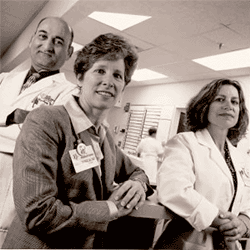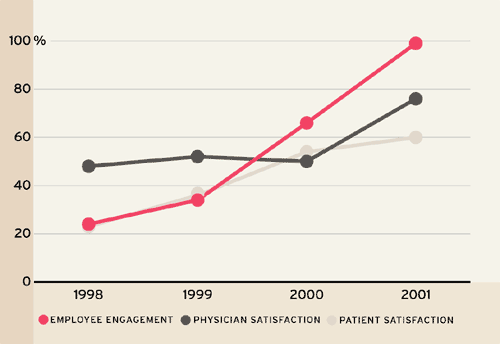Two years ago, St. Lucie Medical Center, a 150-bed for-profit hospital in St. Lucie County, Fla., was treating more patients, more profitably than at any time in its 16-year history. Yet the hospital was ill. Patients were streaming in, but the influx owed more to demographics -- the aging population of St. Lucie County was doubling every decade -- than to anything exceptional about St. Lucie Medical Center. Even more troubling, the hospital's workforce, some 700 nurses, clinicians and support staff, was heading for the exit at an alarming pace: Annual turnover was 35%, a rate that was dismantling institutional memory, impairing productivity and crimping profits. Worst of all, physicians who referred patients to St. Lucie were put off by the staff's pervasive discontent, threatening the hospital's long-term competitive prospects.
Now, fast-forward to September 2001: The employee attrition rate has dropped significantly -- nurse turnover, in particular, declined by almost 50%. What's more, engagement, a measure developed by The Gallup Organization to assess how fulfilled employees feel in their jobs, soared to the 99th percentile in Gallup's worldwide database (no other company has ever achieved a 99th-percentile placement). Not surprisingly St. Lucie customers -- patients as well as physicians -- are much happier (see the graph on page 12). The hospital's percentile placement in patient satisfaction among its peers (the other hospitals owned by HCA, the largest hospital chain in the world) soared 160%, while its ranking in HCA's physician-satisfaction database jumped 72%. "The growing satisfaction among our two key constituencies, patients and physicians, is the most important proof that our determination to transform our culture has been successful," explains Nancy Hilton, St. Lucie's chief nursing officer (CNO).
The power of St. Lucie's story is that the method of its remarkable turnaround can be applied to any workforce-challenged company. The secret is simple: Make sure employees are working in groups that require them to do jobs they are naturally wired to perform, and measure how well they're doing. Here's how St. Lucie did it, and how other companies can follow suit.
Executives at St. Lucie had the foresight to realize that they couldn't boost or even sustain profit growth without turning their existing workforce into a more stable and energetic one. So they embraced an ongoing effort -- part soul-searching, part tactical maneuvering -- to revitalize their human assets. The aim, quite simply, was to make each employee a diehard loyalist.
But what was the baseline? Where was the improvement going to begin? In short, how would St. Lucie know if its turnaround efforts were pointed in the right direction? That's where Gallup's Q12 metric, a 12-question survey that measures employees' engagement on the job, came in. When engagement is high, Gallup has shown, employees are more productive and their company is more profitable. Conversely, when employees are disengaged they create a drag on productivity and profits.
 |
|
|
St. Lucie's workforce completed its first Q12 survey in 1998, with discouraging results: It ranked in the 24th percentile in Gallup's worldwide database. The study illuminated a woeful lack of open and constructive discussion, within work units, about ongoing needs and opportunities related to delivering the best possible service. As a result, exceptional workers found themselves looking for positions at other hospitals where they would feel more appreciated, while employees who would otherwise have taken pride in doing their best on the job were feeling the wind taken out of their sails.
Happily, the study also revealed that St. Lucie had impressive pockets of very highly engaged work units, including some of the best units Gallup has ever studied. St. Lucie set out to replicate the dynamics of those best-in-class work units across the entire organization, starting at the top. "We realized that better understanding our own individual talents as well as the talents of our peers would be one of the keys to our success," says Hilton.
So the CEO, CNO, CFO, and 25 department directors underwent highly structured personal interviews, based on profiles of excellence specific to leadership in the health-care industry. Gallup identified these profiles through decades of in-depth talent assessment analysis. The interviews enabled Gallup to create a talent inventory of St. Lucie's leadership team, demonstrating how the talents that constitute the leadership profile -- such as managing relationships, building constituencies, ensuring excellence in execution -- were accounted for and who in particular possessed them.
In this way, the leadership at St. Lucie, working with Gallup, was also able to assess which job responsibilities had been improperly assigned to individuals not best suited to fulfill them, and how they were lacking as a team. "Of course we always thought of ourselves as a purpose-driven organization with a very meaningful calling," says Hilton. "But the process of assessing our talents really drove home for us that we needed to do a better job of setting direction and articulating the hospital's vision -- of making sure that we were achieving our purpose of serving patients and physicians as well as possible."
Being true to the hospital's vision, St. Lucie's leadership realized, would require getting a better handle on the performance-related talents of its entire workforce. So Gallup conducted another series of talent-assessment analyses, this time involving 50 of the hospital's "role model" employees, including top performers for every job function in the hospital (nurses, clinicians and technicians, as well as secretarial, support and food-service staff). The very act of carrying out these assessments had a positive effect in the workplace: each of the employees chosen to participate in the study received a welcome boost of well-deserved recognition.
The results of all this talent analysis were telling: Directors displayed high levels of courage, responsibility, caring, problem-solving, integrity and achievement. But they were lacking when it came to team-building and the ability to motivate employees and develop their work skills. So it was no surprise to discover that, even though role-model employees exhibited extremely valuable traits -- high levels of responsibility, pride in their work and team-orientation -- they felt the hospital was not necessarily leveraging their strengths.
Translating these findings into an actionable plan was the next and greatest challenge: How could St. Lucie turn these insights about the richness of its talent inventory into practical improvements in its workplace culture? The answer was team blends. Armed with knowledge about their own strengths and the strengths of their workers, directors of various departments (emergency, O.R., pharmacy and the like) could construct work units around the complementary talents of individual employees.
|
|
 |
"It's like chemistry," explains Kelley Charles, director of laboratory services. "If I know this person is, by nature, extremely positive, always looking for the silver lining, and that that person is instinctively drawn to identifying problems that need to be fixed, then the complementarity of their talents will make it easier for them to have a valuable impact on the performance of the group." That makes intuitive sense: A supervisor who can match up employees with complementary strengths will preside over a more effective workforce than one who tries to get employees to exhibit traits they simply don't possess.
At St. Lucie, one of the most valuable consequences of this process was to enable nurses to place themselves in the most effective functions relative to their peers -- to see who among them had the highest levels of empathy and who had the highest level of operational talent. As it turned out, the most empathetic nurses tended to struggle with time-management, while those with outstanding work-style talent found that work-flow efficiencies came easily to them. Paying attention to these distinctions made individual nurses happier in their jobs, and made the nursing division as a whole better able to deliver empathy to patients and operational excellence to physicians.
The success of St. Lucie's turnaround is not only evident in its skyrocketing patient and physician satisfaction scores but in the extraordinary advocacy that its workforce has come to exercise for the hospital. In two years St. Lucie's employees jumped to the number one placement among the 200 HCA hospitals evaluated by Gallup on three key business outcomes:
- "I plan to be working in this organization one year from now."
- "I would recommend my facility as a place to work."
- "I would recommend my facility to family and friends if they needed medical care."
What are the key lessons that St. Lucie is applying as it goes forward? Hire with an eye toward complementing individual strengths in work groups. Commit to ongoing discussion and feedback activities that enable periodic re-evaluation of team blends among directors and within work units. And be ready to carry out the organizational restructuring that is likely to be necessary as a result. Once you get started down the path of measurable improvement, success becomes the biggest incentive for doing the right thing, over and over again.